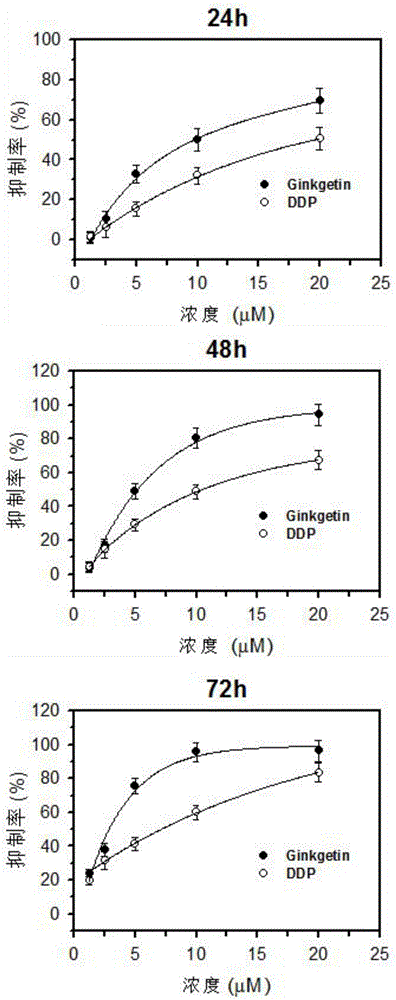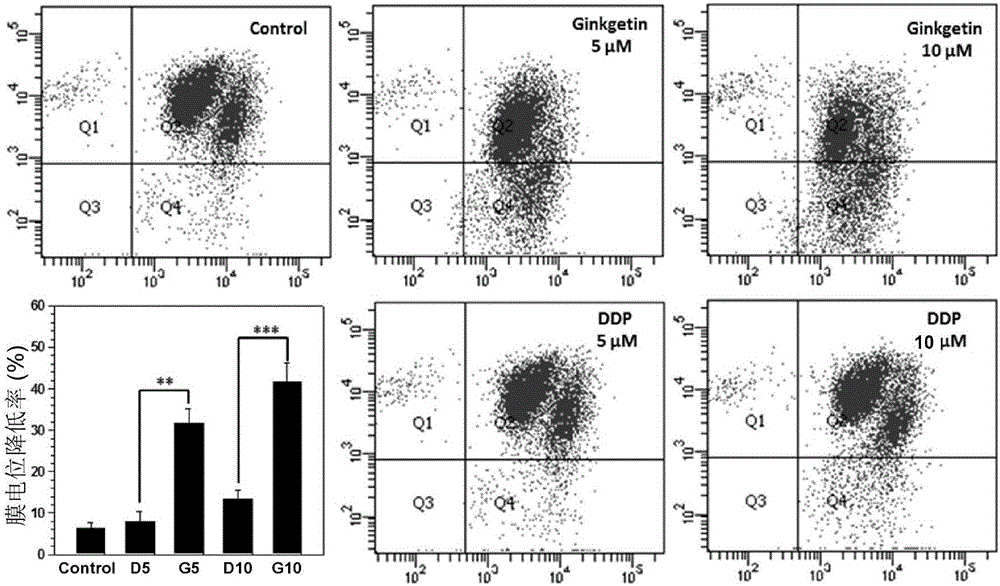Novel application of ginkgetin
A technology of ginkgo biflavones and biflavonoids, which is applied in the field of medicine, can solve the problems of non-small cell lung cancer research that has not been reported, and the research on the antitumor efficacy of ginkgo biflavones is rare.
- Summary
- Abstract
- Description
- Claims
- Application Information
AI Technical Summary
Problems solved by technology
Method used
Image
Examples
Embodiment 1
[0031] Example 1: The Toxic Effect of Ginkgo biloba Flavonoids on A549 Non-small Cell Lung Cancer Cells
[0032] 1. Cell culture
[0033] Get A549 cells and cultivate them in 1640 medium, which contains 10% fetal bovine serum, penicillin 100U / ml, gentamicin 100ug / ml, 1mM amino acid and 0.1mM sodium pyruvate, and the temperature of the incubator is 37 °C, with 5% CO 2 .
[0034] 2. Cytotoxicity Assay
[0035] A549 cells were planted in a 96-well plate with a cell density of about 3×10 per well 3 After 24 hours of cell attachment, give different concentrations of ginkgo biloba and cisplatin, add MTT staining after 24 hours, 48 hours, and 72 hours, and discard the original culture medium after 4 hours of staining, add DMSO to dissolve, and put it into a microplate reader , the absorbance was measured using a detection wavelength of 570 nm.
[0036] For comparison results, see the attached figure 1 and Table 1. The results showed that ginkgobiflavone had strong cytotoxic ...
Embodiment 2
[0039] Example 2: Ginkgo Biflavone Increases the Mitochondrial Membrane Potential of A549 Cells
[0040] A549 cells were planted on a 6-well plate with a cell density of about 5×10 per well 4 Let the cells adhere to the wall overnight, add different concentrations of Ginkgo biloba (5, 10 μM), and replace the culture medium before adding the medicine. 24 hours after adding the drug, discard the medium, wash twice with PBS, digest and collect the cells, add serum-free culture containing JC-1 with a final concentration of 5 μg / μL, and label with fluorescence at 37°C for 0.5 hours, centrifuge to discard the medium, wash with PBS Twice, resuspended and detected by flow cytometry, the excitation wavelengths are 488nm and 561nm.
[0041] For comparison results, see the attached figure 2 . The results showed that Ginkgo biloba could significantly increase the reduction rate of mitochondrial membrane potential in A549 cells, which was significantly higher than that of cisplatin at ...
Embodiment 3
[0042] Example 3: Ginkgo biloba increased the production of reactive oxygen species (ROS) in A549 cells
[0043] A549 cells were planted on a 6-well plate with a cell density of about 5×10 per well 4 Let the cells adhere to the wall overnight, add different concentrations of Ginkgo biloba (5, 10 μM), and replace the culture medium before adding the medicine. 24 hours after the addition of the drug, add serum-free culture containing DCFH-DA with a final concentration of 15 μM based on fluorescent labeling at 37°C for 0.5 hours, then discard the medium, wash twice with PBS, digest and collect cells, and use flow cytometry for detection. The detection excitation wavelength is 488nm. The experimental results are the average value of three experiments, and three holes are made in parallel each time.
[0044] For comparison results, see the attached image 3, the results showed that: Ginkgo biloba can significantly increase the production of ROS in A549 cells, and it was signific...
PUM
 Login to View More
Login to View More Abstract
Description
Claims
Application Information
 Login to View More
Login to View More - R&D
- Intellectual Property
- Life Sciences
- Materials
- Tech Scout
- Unparalleled Data Quality
- Higher Quality Content
- 60% Fewer Hallucinations
Browse by: Latest US Patents, China's latest patents, Technical Efficacy Thesaurus, Application Domain, Technology Topic, Popular Technical Reports.
© 2025 PatSnap. All rights reserved.Legal|Privacy policy|Modern Slavery Act Transparency Statement|Sitemap|About US| Contact US: help@patsnap.com



